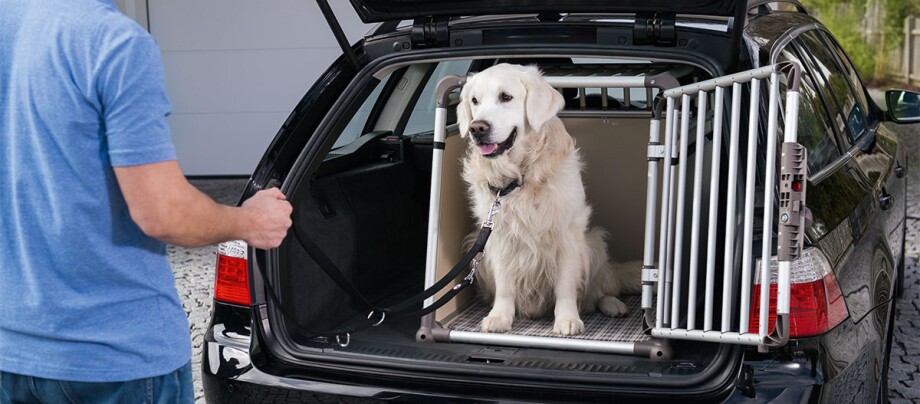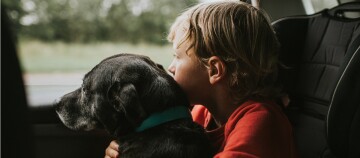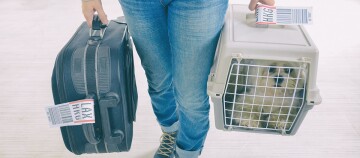Transporting Dogs in the Car – Tips for Getting Dogs Used to Safe Car Travel
07.10.2022 - Reading time: 4 minutes

When driving, a dog is considered “cargo” from a traffic law perspective. According to the Road Traffic Act §23 StVO, this cargo must be secured during the car journey in such a way that road safety is not impaired at any time. Violations are punishable by fines. In the case of acute danger, there is even the threat of points in Flensburg. This may not be comprehensible to the owner of a chihuahua, but it quickly becomes serious when you consider the following – in a head-on accident at 72 km/h, a dog with a weight of 23 kg creates an acceleration mass of up to 1,800 kg. Read here to discover the most appropriate transport and securing system for your dog!
Car travel with a dog – safety first
The type of transport and safety system that is right for your dog depends on the size of the dog and the car.
- Small dogs are safer in special transport boxes, especially if you are driving alone.
- Larger and very large dogs often don’t fit in a box on the rear seat but instead need a transport box made of metal in a correspondingly large boot.
- Mid-sized breeds, on the other hand, can often be well-secured using a special harness and seat belt.
For the sake of your own safety and the dog’s, you should avoid prioritising price or looks when choosing the right safety system.
Transport boxes and seat belts for dogs: what you should consider
This picture shows ways of safely driving with your dog in the car.
The safest way to drive with your dog is in a transport box, provided it is installed in a species-appropriate way and there is sufficient space in your car. The safest lockable models, made of metal and that can be fastened to the floor, are only appropriate for station wagons or other cars with a spacious boot.
These metal boxes have lots of advantages:
- In the case of an accident, your dog cannot be thrown through the car.
- The “cage” protects the dog from the force of the impact from another car.
- The dog cannot get out and impede rescue workers.
Whether a transport box on the back seat makes sense depends on the size of your dog and the available means of securing it. Transport boxes such as this are advantageous for small dogs in particular who cannot be properly secured with a seat belt.
Remember: A transport box must be secured to the seat with a seat belt. Do not squeeze the transport box between the seat back and the rear seat because animals can be crushed there in an accident. It is also too hot for them there.
It is not recommended to transport a dog unsecured in the boot of a car because, without a properly secured transport box, he may be severely injured or killed in the case of a rear-impact accident. A divider over the rear seat at least provides for your safety. Not all dogs like to sit in a box, not all owners want to deal with a transport box and not all cars are equally appropriate for carrying one. A good alternative, which is also safe and inexpensive, is a special harness and seat belt for the dog to wear in the car. For this, you don’t have to install anything and the dog stays close to his people in the body of the car.
Tip: Indulge yourself and your car with a special protective blanket to keep doggy claws and fur off the boot floor and upholstery.
Maxi Zoo can advise you individually at any time on the best solution for you and your dog at one of our shops.
Here’s how to get your dog used to safe travel in the car correctly
So that your four-legged friend enters the transport box without complaint, he needs to get to know it as a safe and comfortable “den”. Otherwise there is a risk that your dog will be enormously stressed. Some dogs react with fear and aggression at being caged. That’s why it is especially important to introduce a transport box over a period of time at home before you use it in the car.
Tips for getting dogs used to safe car travel:
- Ideally, you should offer your dog the new box as a place to snuggle at home. Equipped with a soft blanket and a toy, it might even give your dog’s basket a run for its money. A well-worn t-shirt that smells like you makes the transport box even more comfortable. Only place the transport box in the car once your dog is happy spending time in it.
- As additional motivation, you can use praise and a treat to help get your dog into his cosy “den” for a car trip. Start with short distances. First select a destination that will delight your dog, such as a field or dog park, where he can run around freely. Repeat this procedure a few times, so that your dog doesn’t just accept the transport box, but also associates very pleasant things with going for a drive.
- When you buckle your dog into the rear seat with a special safety harness for the first time, you should also start with an orientation phase.
- It’s good if someone can accompany you on these first trips who can sit next to the dog and check that his harness and belt are secure, comfortable and safe during the drive. If the harness is uncomfortable or the dog is being thrown around the rear seat at every bend, then he will try to avoid car journeys with you in the future. Furthermore, an incorrectly adjusted harness actually represents a risk of injury to your dog.
If your dog suffers from nausea, fear or even panic during car rides, then seek advice from a specialist dog trainer. You can help a fearful dog on long car journeys with homeopathic substances, such as the well-known Bach flower “Rescue Drops” or other gentle medications. Speak to your vet or an alternative animal healer you trust.


